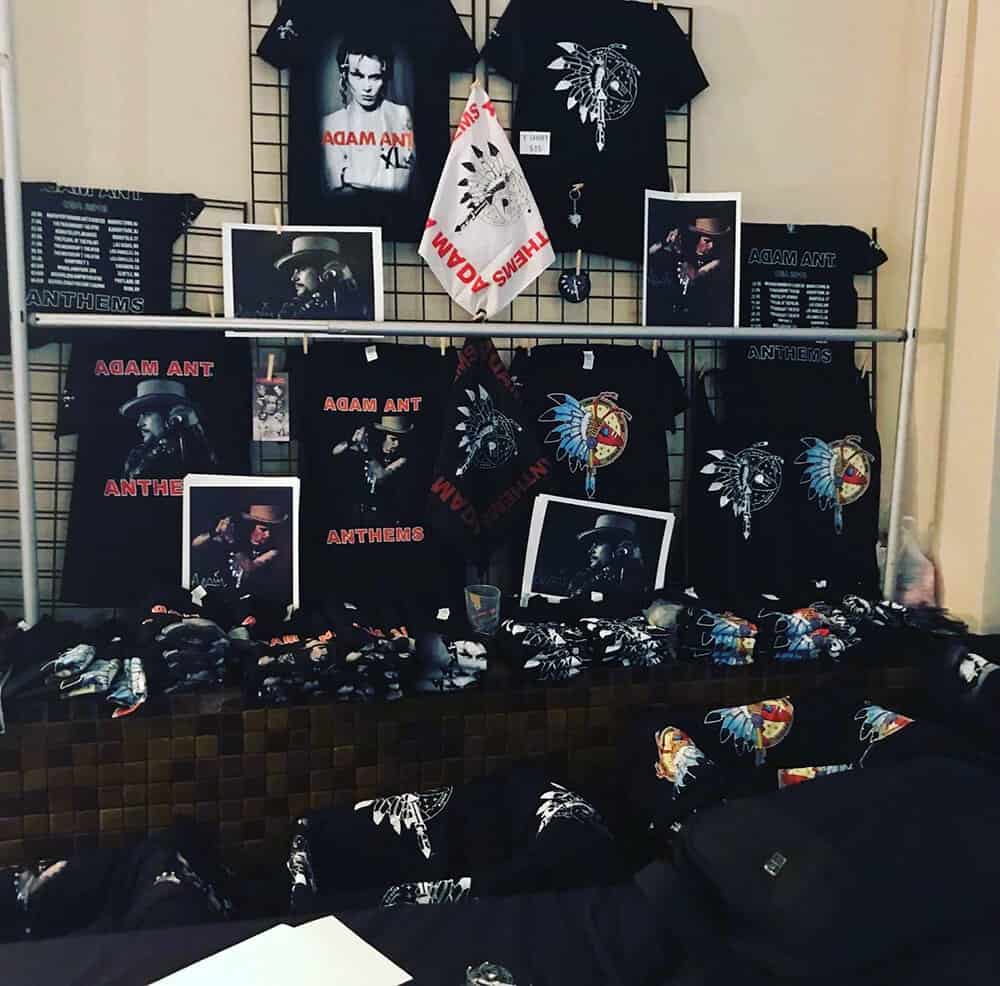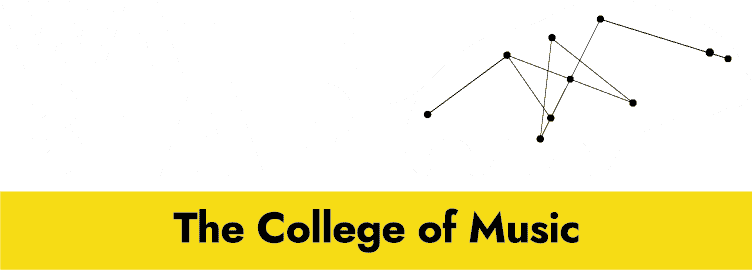JOIN US SEPTEMBER 2024 - APPLY TODAY OR BOOK YOUR PLACE ON ONE OF OUR OPEN DAYS IN BRIGHTON OR SHEFFIELD. UCAS CLEARING IS NOW OPEN.
JOIN US SEPTEMBER 2024 - APPLY TODAY OR BOOK YOUR PLACE ON ONE OF OUR OPEN DAYS IN BRIGHTON OR SHEFFIELD. UCAS CLEARING IS NOW OPEN.

Bands, fans and merchandise have a three-way relationship that go back a LONG way! Fans love band-branded merch. That makes it sellable, and just like points make prizes: merch sales make revenue and profit! Merch sales can be a valuable weapon in an artist/band’s arsenal & part of your revenue stream early on and as your career develops. That’s truer than ever in an era when the music retail market has changed so drastically. But (as you’ll have seen in these blogs and in WaterBear’s 21st Century philosophy), there’s no point in crying over spilt milk and yearning to recapture the pre-digital age. Bands have to adapt to the new conditions of reality - the new tech, business methods and markets - and these are still forever changing! Artists and bands that adapt, in agile and apt ways, can prosper (often in ways that give them more independence and control than old-school record deals and set-ups would have allowed). That’s part of WaterBear’s philosophy too.
In the music business, we’ve seen a world of bits rise up to challenge the world of atoms. The effects on the industry have been seismic: digital downloading, streaming audio and video (often for free, ad-supported or on subscription models) have altered the playing field. So, sadly, has digital piracy.
Bits can be copied, downloaded and streamed, often without generating sales or revenue for the artist or label. In these digital times, physical merchandise and direct experience matter. Atoms are harder to copy than bits!
What’s more, as you know, fans just love merchandise because it’s tangible and they can own it! They can wear clothing and accessories that identify them with their idols and proclaim their fandom. They can adorn their walls with posters. They can covet, collect, trade and gift memorabilia and mementos. Thankfully, such demand hasn’t been eroded by digital music distribution. It’s remained strong. Arguably, it’s become more important than ever! Sourcing, producing and selling merchandise can be a great way to commoditise and monetise your band, your brand, and your music. This blog will tell you how to go about it, with expert inside advice.
Traditionally, special merch deals have been available, where a merchandiser can allow a band to get supply of product from them on an advance basis. Such deals have become less common and popular of late (in 2018) especially with new bands because the production techniques and supply chains have become much more agile. That means that bands don’t necessarily need to put up money in advance OR rely on a merch deal. You’ll learn what’s what in this brave new world from our expert below.
As you’ll see, merchandise is still a powerful tool and source of income.
The opportunities for selling merchandise are many. The obvious and traditional market is at concerts, live appearances, gigs and festivals (especially when the artist/band can sell directly to fans rather than via third-parties). There are also well-established non-concert channels and outlets (such as high street and specialist shops, including record shops, music stores, and poster shops). Then there’s the enormous potential of online sales and e-commerce, e.g. from the band’s website (perhaps promoted on social media platforms or sold via the band’s Facebook page from a service like Shopify); alternatively, an outsourced web store with back-end fulfilment for the orders. There are a lot of options!
Let’s introduce our industry expert and learn a VERY IMPORTANT LESSON!
Our industry insider expert on merchandise and merchandise deals is Roy Jenkins from Noise Merch (www.noisemerch.com).
Roy and Roger Hunt set up their successful merch company off the back of Noise Management, having managed artists first. Roy also comes from a band background, having been a musician himself. Noise have been supplying merchandise for more than 20 years now. The company notes on its website, “If you are in a band or simply just an avid gig goer then you will have either ordered merchandise from us or brought one of our items at a show or venue worldwide.”
It’s an ever-changing market. When Roy started, he had no idea how the industry would unfold, let alone that records would stop selling! He remembers back in the record stores it would be: buy the record and get a free t-shirt. Now, we’re through the Looking Glass: buy a t-shirt and get a free CD! This importance of that 180-degree turn CANNOT be understated!
Amazingly, some people in the business now consider physical CDs at gigs to be merch on par with the more traditional clothing, accessories and memorabilia; not as a separate kind of product, because it’s a single, EP or album. Anything that’s not digital can be merch, by this way of thinking.
Now, over to Roy Jenkins, our industry expert, for the WaterBear interview…
WB: Hi, Roy. Could you explain what Noise Merchandise does?
Roy: “Noise Merch provide bands, brands, festivals and event organisers, PR companies, designers and charities with professional merchandise products.
“This can be start from your ideas and your designs, or we can provide you with designs styles and product ideas, based around your brief or once we get to know your needs. If you’re running either a tour or an event, then we can also provide detailed forecasts on predicted sales to make merchandise a more profitable concern for the client.
“As Noise is based in the UK this is our strongest territory, but we successfully run merchandise for world tours for a wide number of big artists. Providing Touring merchandise, event merchandise concession and online fulfilment, designs and logistic worldwide.”
WB: What is Merchandise. as a concept?
Roy: “Merchandise to me is about an identity for a band or brand and that’s what we do. So when I’m working with merchandise for a specific band, its’s a challenge to look at that band and find out what fits.
“I have always tried to work with the bands that I like, but I have worked with loads of different artists.
N.B. Noise’s client list is impressive and varied, they have worked with global brands and bands over the years, with the likes of Adam Ant, Dr Feelgood, Killing Joke, Echo & the Bunnymen, The Alarm, Sepultra, Skindred and Skunk Anansie, Beggars Banquet Records, Fields of the Nephilim, and many more!
Types of Merchandise
The most obvious and traditional type of merch is band-branded clothing, and the most common form of that is of course the ever-popular t-shirt! However, t-shirts are far from the only kind of garment or item that can be merchandised…
- Hoodies are popular, so are jackets, windbreakers, crew gear, bandanas, caps and hats, etc.
- Then there are non-clothing accessories: jewellery, metal badges and embroidered patches, lighters
- Mugs, glasses, towels
- Photos, posters, prints
- Books, booklets and ‘zines.
Phone cases have proved particularly popular, given that so many people (a whopping 79% of us!) have mobiles and many accessorise them. Phone cases are a great way to get your brand, logo and likeness out there, and for your fans to show their allegiance and support for you.
A lot of these products benefit from the latest printing techniques, like screen printing and digital printing inks and technology available on the market. These can be used to brand, merchandise and personalise a wide range of item, with high quality. They can also be used to print on demand, which as we’ll see, has implications for your merch inventory and stock control.
Graphics, Imagery and Branding
Picture what you want YOUR merch to look like. The visuals are worth thinking about. In our last blog, we covered how to approach a photoshoot and use the photos promotionally, in various ways. Putting those photos on your merch is a great use of them.
You may want to opt for a more graphic than photographic approach on some or all of your merchandise. In that case, follow a similar discipline to finding a good photographer (as we covered last time).
- You might have the flair and skillset to create artwork, imagery and logos yourself.
- You might find an artist or designer (e.g. via a college) who’s keen to work with you for practice, exposure and credit.Alternatively, you might seek out an established professional and be willing to pay for more the work.
- There are various outsourcing websites and apps that provide marketplaces that can put you in touch with freelancers (e.g. Fiverr, Upwork, and People Per Hour) on a job-by-job, ad hoc basis, for reasonable rates.
- You could also run a competition or request submissions from your fans (and award merch as a prize!)
N.B. Merchandisers sometimes provide in-house design art and art generation in their services or can broker contact with artists and designers.
Pay attention to your logo, which is a major identifier for the band. Great logos catch the eye, stay in the mind and convey something about the band’s image.
Popular images for merchandise include:
- The band’s logo
- Graphic images, including representations of mascots etc.
- Album covers (also EPs & Singles)
- Tour poster/images
- Photos of the band & its members
- Photos of the band on-stage, either posed on in live performance, or in action shots
W.B: Why are sales of merchandise important today? What part does they play in the bigger picture?
Roy: “Merchandise is more important today than it ever has been, as the bands have stopped making money from selling their music. This makes merchandise one of the biggest parts of their income. This applies to the tours, through their online store and VIP packages. If all these things are looked at properly and planned out you will then see all the rewards pretty early on. “
W.B: So, when should a band look at producing and selling merchandise?
Roy: “Do it straightaway! Get friends and family to start wearing logos on t-shirts right away building up the brand association and get the free advertising going right away!”
W.B: What’s the upfront cost to bands who want to source and sell merch? A lot of bands are under the impression they need a bit of money to get going.
Roy: “Everything has now changed due to the digital set-up. The band can upload all the designs and print (as long as they are onto 100 percent cotton) to the store on Noise. The product doesn’t have to be made to order. This can be slightly more expensive to make, but the flipside is that there are then no storage costs.
“The merch company would then print as they go and then take their cut and then pay the band’ alternatively, the band can upload the images on to their store and pay the merch producer for the printing. “There are no upfront costs anymore this way for online merch, which is great for new bands and a way to get going and make some money straightaway.”
N.B. This is important to grasp! Once upon a time, it used to be necessary to order and hold inventories of physical stock. These would be used to supply orders from direct sales and mail order. Latterly, they’d be used for online sales. Also, as you’d expect, for sales at concerts and similar live appearance events.
These days, use of produce- and print-on-demand services have cut the need for that in all these scenarios. This cuts out the need for storage, warehousing and transporting inventory to and from gigs. Even for sales of merchandise at concerts, this new technology and method of print/produce on demand has important implications!
Here’s Roy’s valuable insider advice on this: “A band might land a brilliant tour support to big venues. This means they can often get over-excited, which leads them to over-print/produce for the merch stands.”
These days, thanks to print/produce on demand technology, concession fulfillment services, etc. there’s no need to be bound to this model. Someone like Roy or Noise can offer advice and services that support tours with the band selling their merch.
Roy might, for instance, advise that instead of printing out 1000 t-shirts, a band might go instead for just 50/100, then gauge how the first 3 nights of the tour go in terms of sales numbers and patterns. Then, known what’s selling and what isn’t, print out more of what is, if need be. Keep It Simple: Don’t go mad & merchandise everything (including the kitchen sink) or create too many variations!
One practical warning: Roy also warns against ordering too many different varieties in different colours. Know your demographic - your audience and market - well. Be realistic! It’s all very well spending money on lots of quirky ideas and novelties (lighters, badges even aprons etc.) but do your research on your fans beforehand. If the basics (such as hoodies and t-shirts) that are selling and producing the lions’ share of your sales. Don’t fix what’s not broke! And don’t stock up on what’s not selling!
WB: So, Roy, what are merchandise deals? Can you explain for our readers?
Roy: “Merchandise deals are when you’re offered an advance, similar to the record deal model, and then once everything has been sold, you then receive a percentage of the sales.
WB: Why and How Does the Advance Nature of Such Deals work?
Roy: “These deals (like record deals of old) are put in place, because the company offering the advance know they will make money, and the party signing the deal, generally don’t have the money or don’t want to outlay the initial payment.” “Moving into 2019, and with all the information from past years, things have changed and the young bands coming through understand all of this.”
That said: “If you’re a successful band then there is always a deal out there to be got. This can come at any stage, as you can have a big success with merchandise, before you are selling a lot of records.”
WB: Thanks, Roy, that’s really useful advice!
Recorded music has become digital. Like much media (games and movies included) it’s evolving into streaming or cloud paradigm. We’ll be covering digital distribution in a blog very soon. Along the way, many consumers - and even fans - have grown up no longer wanting or expecting to pay for a physical single, EP or album. Some, though, are still keen to purchase and own that physical thing. The CD has, as we’ve noted, become merch in its own right. Physical, tangible things that you can hold and own that still appeals to many, especially to fans, and particularly as mementos of live experiences, like a gig or tour.
Merchandising can be a valuable revenue stream. In a band’s early days and career cycle, it can bring in valuable income and profit, and can continue to be so, even when the band breaks and makes it. Capitalise on that, and use the kind of fast, agile production-and print-on-demand services that are now available to source and produce stock, and you’ve got a way to make money, generating revenue and offsetting tour costs, and to keep your fans happy, without having to put up a lot of money up-front.
Other forms of merchandising deals do exist, where for example merchandisers approach bands and buy the rights to produce and sell the band’s merch on agreed terms, but that tends to be further into a band’s career cycle and seldom, if ever, is offered to them in their early days.

- ‘Water bear’ is the common name for a Tardigrade.
- Tardigrades are micro creatures, found everywhere on earth.
- They are the most resilient creatures known.
- They can survive and adapt to their surroundings, even in outer space.
- Their resilience and ability to adapt and survive inspires us in everything we do. We love them.


WaterBear Education Ltd, Hanover House,
118 Queens Road, Brighton BN1 3XG, UK Map
Email: [email protected]
Tel: +44 (0) 1273 726230
WaterBear Sheffield, Unit 4, Gatecrasher,
49 Eyre Lane, Sheffield S1 4RB, UK
Email: [email protected]
Tel: +44 (0) 1143 992720

WaterBear Education Ltd, Hanover House,
118 Queens Road, Brighton BN1 3XG, UK Map
Email: [email protected]
Tel: +44 (0) 1273 726230
WaterBear Sheffield, Unit 4, Gatecrasher,
49 Eyre Lane, Sheffield S1 4RB, UK
Email: [email protected]
Tel: +44 (0) 1143 992720
- ‘Water bear’ is the common name for a Tardigrade.
- Tardigrades are micro creatures, found everywhere on earth.
- They are the most resilient creatures known.
- They can survive and adapt to their surroundings, even in outer space.
- Their resilience and ability to adapt and survive inspires us in everything we do. We love them.
